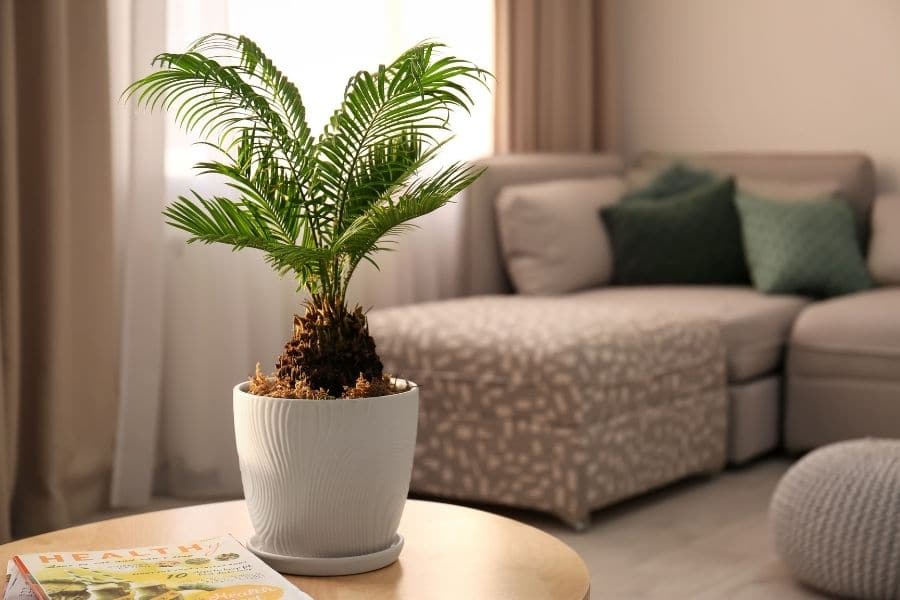
Looking to add some tropical flair to your interior décor? There’s no plant quite like the palm tree to do the job, and here’s everything you ought to know about indoor palm tree care to make sure your palm thrives when kept indoors.
Indoor Palm Trees at a Glance
With so many varieties to choose from (an impressive 2,600 palm species around the world), you will certainly need to do a bit of research on your particular palm tree to give it just the treatment it needs. That said, palms generally share a largely identical set of basic requirements, they easily adapt to growing indoors and they can also take a fair amount of neglect on their owner’s part. All the while cleaning the air you breathe!
Most palms will do well indoors if you can provide them with bright, indirect light and keep the soil in their containers moist most of the time. Ensure there is some humidity in the air, and keep the palm away from cold drafts and blasts of dry, conditioned air. With proper care, your potted palm tree will please the eye for many years to come and grow tall in the process, but remember that you must never trim your palm’s top! Palms grow from the central tip, so make sure the fronds are not pulled at or brushed too much.
Here are some of our favorite palms for indoors, all available for purchase online and at local garden centers:
- Parlor Palm
- Sentry Palm
- Kentia Palm
- Yucca Palm
- Chinese Fan Palm
- Lady Palm
- Areca Palm
- Majesty Palm

You may find that many of them carry a higher price tag than other common houseplants, but we are pretty sure the tropical vibes that come in the package are well worth the extra dollar! In any case, adorning your interior with one of these palms will not be a waste of money as long as you are able to go by these essential rules of indoor palm tree care.
1. Bright, Indirect Light
Common palm houseplants have a natural preference for the shade (especially the Parlor and Kentia varieties), which makes them ideally suited for buildings with little sunlight. Generally speaking, palms are at their happiest when grown in bright, indirect light, but they will also make it through the winter when there’s much less light around.

This is not to say that they will fare well in complete darkness; when there’s no natural light in the room, get a grow light for your plant. Don’t expose it to the other extreme either; if you’d like to give your palm tree a bit of an airing in the summer, place it in a shaded area so that it doesn’t suffer from excessive, direct sunlight. On balance, growing a palm indoors next to a window but without direct exposure to sunlight is easily your best option here.
2. The Right Amount of Moisture
As is the case with many popular houseplants, striking the right balance when watering palm trees is crucial. Your palm may be quite tolerant of being underwatered, but it will only really spring to life if you water it on a regular basis. But here’s the thing: don’t overwater it either! If you keep your palm tree in a container sitting in a saucer filled with standing water, lethal root rot will follow soon after.

As much as possible, try to keep the soil evenly moist – and for this purpose, good drainage in your planter is essential. Water your plant any time you notice the top inch of soil has gone dry, and read your palm’s leaves! If their tips are turning brown, you’ll need to water your palm tree more often; conversely, yellow leaves mean you’ve been watering the plant too generously.
3. A Loose Soil Mix
Indoor palm trees are generally easy to please when it comes to the soil they sit in, and a regular commercial potting soil will make them perfectly happy. A loose, porous soil mix will bring best results as it makes it easier for water to drain, and for air to flow through your plant’s container. Put simply, efficient drainage will result in a healthy palm tree.

Potting mixes are made of lightweight materials such as peat moss, vermiculite and perlite, and they’re designed to increase the porosity of the soil (which helps to increase the plant’s drainage). And if you’d like to take it a step further, there are also special palm soil potting mixes available in the market, and they’re made specifically for growing palms.
4. Some Fertilizer (During the Growing Season)
Your indoor plant trees don’t need to be fertilized, but they will certainly be grateful if you feed them anyway! There is one condition though: do it during their active growing season, namely during the spring and summer; fertilization during the fall and winter isn’t recommended and may actually do more harm than good.

Some palm varieties are known to be sensitive to synthetic fertilizers, so be sure to use organic fertilizer instead. There are many types of organic plant fertilizers readily available for purchase in garden centers, including dedicated palm fertilizers containing exactly the sort of a cocktail of micronutrients and potassium required to give your palms a healthy boost.
5. Careful Pruning
Palm leaves can turn yellow or brown naturally as they grow old, and as a loving plant parent you will find yourself eager to help your palm tree and prune off any leaves looking past their prime. Before you get too loose with your pruning shears, however, remember that old, discolored fronds continue to be a valuable source of nutrients for your palm tree – even if you find them a bit unsightly!

Over-pruning means that you’re essentially making things harder for your plant, so trim your palm tree with caution, and only remove leaves when they have turned fully brown. Don’t cut the entire frond back to the stem of the palm just because the tips are discolored, and never prune your palm tree for size.
6. Natural Pesticides
Just like many other houseplants, your indoor palm tree can be attacked by a number of bugs. Spider mites are easily the most common pests, but scale insects and mealy bugs can also infest your palm occasionally. But rather than fight these unwelcome visitors with chemical pesticides – and harm yourself and your pets in the process – hit them with non-toxic solutions and natural pesticides instead.

These include organic and horticultural oils as well as insecticidal soaps; whatever remedy you choose, it’s important that you should start the treatment immediately. You may also find that raising air humidity around your palm tree will help to keep spider mites at bay – which, incidentally, will also make your tropical plant feel more at home.
7. A Well-Chosen Container
Most palm trees have shallow roots systems and don’t like to be repotted too often, so let them grow in the same container for a few years until they are fully pot-bound. It’s also an efficient method of keeping their size in check; given more room to stretch their roots in their pots, many popular indoor palm varieties will grow perhaps a bit too quickly for your liking.

The container you pick will likely be your palm plant’s home for at least a couple of years, so choose it wisely. For starters, get a pot with drainage holes to make indoor palm tree care much easier for yourself! Our universal fiberglass planters are both practical and pretty, so be sure to take a look at our extensive planter collection.
And if you want to look at our planters in action, be sure to check out one of our projects here:

Zola Properties – 812 Huntley, Hollywood
The client wanted to find planters and plants that would thrive in the harsh sun and heat of California. Many common houseplants and planters will simply not survive or do well in these conditions.
View ProjectNow you know how to take care of your Palm Tree, it’s time to learn the best way to use it in your decor with our palm tree landscaping guide.